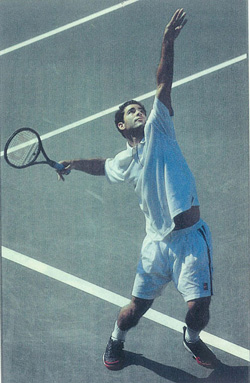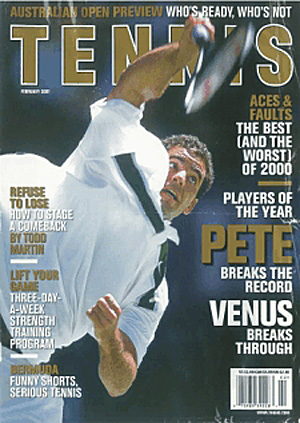|
TennisOne Lessons Building Your Serve Using the Pete Sampras Model Jim McLennan
Pete Sampras rode his serve to 14 Grand Slam titles. Playing with incredible confidence, in many matches he needed but one good return game per set, knowing his serve would rarely if ever be broken. Aces delivered seemingly at will, many have and did serve harder, but no one has ever served with more accuracy. In an interview about his seven Wimbledon titles Sampras said, "I had the best second serve in the game." His rival, Andre Agassi, would eat up any and all short or predictable second serves, but rarely got the chance against Pete. On that score their Grand Slam record was somewhat one sided, Agassi beat him at the 1995 Australian Open, but Pete prevailed in the finals of the 1990, 1995 and 2002 US Opens, and the 1999 Wimbledon final. I believe there are common elements present in all good serves. Pete and Roger have certainly mastered these elements, but players who struggle with their serves (whether professional – read Sharapova, Safina, et al, or recreational) have missing aspects to their service delivery that diminish their power or accuracy.
I presented "Teaching the Serve – Methods, Models, and Transfer of Skill" at the recent 2010 USPTA World Conference (it took some effort for me to move from the pool to the seminar room), and in discussions with many of the seminar attendees, I sensed a wide range of points of view and teaching methods on the serve. But interestingly, these same coaches are much more "of a same mind" when teaching the forehand. Translated, many view the serve as more of an individual thing, but not so the forehand. So in the interest of full disclosure, I believe the serve is no more an individual issue than the forehand. And that the common elements present in all the good serves are basic, foundational, and not subject to individual preference. Want to serve better? Go back to the basics. And no one was ever more basic than Pete. Relaxation Fred Earle, an old friend and mentor, said that first and foremost Sampras had the most relaxed delivery he had every seen. Check the photo of Sampras on the right, and notice Pete's fingers, they are barely holding the racquet. The looser the grip the more you can whip the racquet, sort of like snapping a wet towel. The great Pancho Gonzalez was known to serve with his pinkie if not his ring finger off the end of the handle to loosen his motion. Before anything else on your own serve, monitor tension and whether you are initiating your serve with a tense or tight grip. Further, note the precise nature of your grip, Pete was serving with a continental, anything less and this serve is not destined to come together. Rhythm Some players use exceedingly high tosses (Soderling or Berdych), some use unusually low tosses, (Ivanisivec or Tanner) seemingly hitting the ball on the rise if not at the peak of the toss. In Pete's case the toss peaks perhaps 12 to eighteen inches above contact and I believe the relative lowness of this toss allows him a rhythmic continuous delivery. No stops, pauses, or hitches from overly high tosses as we see on the recreational court.
Pete Fisher, Sampras's childhood coach, when asked how high the service toss, he quickly replied, "four inches above contact." Though Sampras' toss may not be precisely that low, Vic Braden also favored the low toss, and to my mind the key here is continuous flowing rhythm. And before you say that many in the modern game now use a high toss (which might be an evolution in serving style) an exhibition from the old days shown on Tennis Channel featured Rod Laver, Bjorn Borg, Ilie Nastase and Arthur Ashe – and each tossed the ball just high enough to hit, and not a bit higher. If this were good enough for those guys, it would certainly be fine for you, in spite of what you might have heard about high tosses. Tossing Arm Parallel to the Baseline
Years ago we were all taught (or at least many of us were) to toss out in front with the tossing arm often perpendicular to the baseline. This method moves your body weight onto the front foot during the tossing action. But close inspection of Pete shows that his tossing arm is parallel to the baseline, which interestingly keeps his body weight back much longer. Simply put, this allows him to coil or wind up much like a pitcher coils away from the batter before unleashing a pitch. Hit Up All the tennis books recommend swinging up at the ball, but certainly the photos of Sharapova and Safina show a much more forward oriented swing. Del Little, another of Pete's childhood coaches, described an opening warm up sequence for Pete where the first 20 serves were aimed to the top of the fence on the other side of the court, the next 20 were aimed to the opposite baseline, and then accuracy drills would follow. Simple explanation, Pete was drilled to swing up at the ball. Look carefully at the cover photo on the right and notice how the sweat is flying "UP" from Pete's shoulder – this is known as cart wheeling. The Signature Snap I think this signature snap is simply an outcome from all the motions that preceded it. But interestingly, this upside down “V” looks very unusual. And to find this in your game it is not about snapping the wrist, but rather feeling as though the racquet is whipped or snapped UP and Through the ball. Somehow wrist snap causes people to accelerate down, but for this one everything is about up and across the ball. If you tried to snap a wet towel against the wall (or someone’s leg in a locker room) there is a vigorous pulling action and snap but no, repeat no, follow through. For this whipping hit, and Pete again has done this better than anyone, notice how short the follow through appears in the video. Contact well into the court
Finally, in studying Pete’s serve and volley move, his contact is way out into the court (McEnroe found a similar hitting moment). And if you play and replay the following sequence, I find it remarkable that he takes two steps to a subtle split, and additional steps up to and through the ball, where his contact on the volley is well inside the service line. Balance, loose rhythm, swinging up not forward, and snapping the racquet at the top of the swing – you can capture many if not all of these elements within your own serve. Consider a streamlined version of your own delivery for your 2011 New Year’s Resolution. Your comments are welcome. Let us know what you think about Jim McLennan's article by emailing us here at TennisOne. Jim McLennan DVDs
Having Problems With Your Serve?
|


